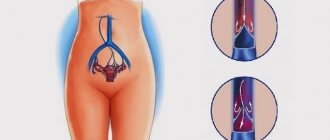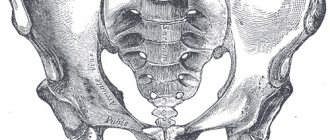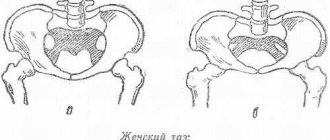Causes and risk factors for the development of ART during pregnancy
The main reason for the occurrence of varicose veins of the small pelvis during pregnancy is venous insufficiency, which is often caused by a genetic predisposition. In addition, the main provoking factors of the disease are:
- congenital pathologies of the development of blood vessels in the pelvis;
- high pressure in blood vessels due to an increase in total blood volume;
- blood stagnation due to hormonal changes;
- hormonal imbalance that arose even before pregnancy;
- decreased tone of the venous walls;
- lack of physical activity;
- passive lifestyle;
- excessive physical activity before pregnancy;
- intense pressure on the pelvic floor exerted by the growing uterus;
- previous thrombosis of the pelvic veins.
The risk group includes women with a hereditary predisposition to varicose veins on the legs and professional athletes. They suffer from pathology of the pelvic veins more often than other representatives of the fairer sex.
Classification
According to the characteristics of the course, there is dilation of the vessels of the perineum and vulva, pelvic venous congestion syndrome. In the first case, the disease develops in the last period of gestation, against the background of varicose veins of the legs. This type of pelvic varicose veins manifests itself by external signs.
Varicose veins of the perineum and vulva are not related to lesions of the pelvis and are diagnosed separately; it can lead to the development of the second form, plethora syndrome, there are no external signs.
Based on etiology, there are two forms:
- primary varicose veins are formed due to incompetence of the vein valves and manifest themselves during pregnancy;
- secondary varicose veins are not associated with pregnancy; they are formed due to diseases and conditions that existed before the onset of pregnancy.
According to localization, pelvic varicose veins are distinguished, when the lesion affects the venous plexuses in the small pelvis, and partial varicose veins, when the vessels are affected.
The development of the disease can be divided into three stages:
- At the first stage, the venous diameter increases to five millimeters, the expansion occurs at the top of the left ovary.
- The second degree of severity is characterized by an expansion of the diameter to one centimeter covering the left ovary.
- At the third stage, the diameter exceeds one centimeter.
Degrees of pathology and characteristic signs
Often the course of the disease can be asymptomatic. Signs of pathology of the veins in the pelvic area are similar to the symptoms of other diseases: gynecological, urological or neuralgic.
General symptoms of pelvic varicose veins during pregnancy:
- the early stages of the disease are characterized by minor discomfort in the pelvis and hips;
- advanced forms of pathology are accompanied by pain in the pelvic area and a feeling of “fullness”;
- swelling of the perineum and legs occurs;
- worries about itching in the genital area;
- worries about the feeling of heaviness and fatigue in the legs, back and groin;
- there is pain during sexual intercourse;
- problems with urination occur.
In the second half of pregnancy, a woman often feels excessive activity of the fetus. This is due to the fact that varicose veins provoke poor circulation and reduce the level of incoming oxygen. In such a situation, the condition of the pregnant woman should be monitored by a doctor to avoid fetal hypoxia.
Treatment methods
Treatment of varicose veins in the pelvic area requires an immediate and comprehensive approach. It is very important to stop the pathological process as soon as possible, thereby minimizing the risk of developing serious complications. Usually during pregnancy they resort to conservative and non-drug methods of treating this disease.
Keep in mind that if pathology is ignored for a long time, the fetus may die due to hypoxia. It is necessary for a qualified doctor to select an individual treatment regimen, which includes:
- Moderate physical activity - try to walk in the fresh air as much as possible. You can also exercise at home. However, before doing this, you should consult a doctor or exercise under the supervision of a qualified specialist. Such therapy will help get rid of congestion and prevent the risk of developing any complications.
- Rest in the correct positions - pregnant women who have varicose veins of the small pelvis are strictly forbidden to sit with their legs crossed, sit, or lie with their legs down.
- Sleeping with your legs elevated will help blood circulate better. At night, do not forget to place a bolster or pillow under your feet to improve blood circulation.
- Proper nutrition - it is very important that a woman receives the necessary set of useful elements from the food she eats. It is also necessary to monitor your body weight - excess weight increases blood pressure, which can provoke the development of complications. You need to eat in small portions, 5-6 times a day.
- Wearing compression garments helps maintain the tone of blood vessels and makes the level of pressure in the pelvis optimal. It can also help reduce congestion.
- The use of ointments and gels - they help improve the tone of blood vessels and relieve pain. Such drugs are the only drug therapy that is allowed during pregnancy.
- Water treatments - various hydromassages, contrast showers and others can give a pregnant woman more vigor and good mood. Also, such procedures increase the tone of blood vessels, muscles and tissues.
- Prevention of hypoxia – due to varicose veins in the pelvis, the risk of developing hypoxia in the fetus increases significantly. To prevent oxygen starvation, you must regularly visit your doctor and follow all his recommendations.
- Pain relief – with varicose veins in the pelvic area, women begin to experience discomfort in the lower abdomen. It is strictly forbidden to endure discomfort; if it occurs, you should definitely consult a doctor.
Diagnostics
To protect yourself and your baby from the serious consequences of pathology, the expectant mother needs to consult a doctor as soon as the first alarming symptoms appear. A phlebologist diagnoses and treats vein diseases.
During pregnancy, the use of most known diagnostic methods becomes unacceptable due to the risk of harming the health of the mother and the development of the unborn baby. The only way to detect varicose veins during pregnancy is to perform Doppler ultrasound of the pelvic vessels. Using this instrumental examination method, it is possible to determine the presence of disorders of the uteroplacental circulation.
Varicose veins can also be diagnosed during a routine ultrasound of the pelvic organs.
Disease prevention
It is better to try to prevent the expansion of veins during the development of the baby with the help of recommendations:
- wear a bandage belt from the middle of the second period of pregnancy, it helps distribute the load;
- strengthen the pelvic muscles;
- follow a diet, deal with constipation wisely;
- do not sit and walk;
- limit physical activity;
- take a contrast shower;
- wear comfortable shoes.
Pelvic varicose veins are a disease whose dangers pregnant women need to think about in moderation. It is important to follow medical recommendations and monitor the condition, but under no circumstances should you worry, this will worsen the situation.
Therapy methods
During pregnancy and breastfeeding, only conservative treatment methods are allowed. Before using any drug, you should always consult your doctor. Self-medication can be dangerous for the health of the mother and unborn child.
Venotonics and phleboprotectors are used as therapy for varicose veins during gestation. Medicines have the following effects:
- improve the elasticity of vascular walls;
- increase their tone;
- restore the functioning of venous valves;
- normalize blood circulation.
The products are available in the form of tablets, taken orally, or in the form of gels and ointments, which are applied to the skin.
List of the most popular drugs for varicose veins that are allowed during pregnancy:
- phleboprotectors - “Eskuzan”, “Phlebodia 600”, “Troxevasin”, “Venoruton”;
- venotonics – “Venoton”, “Venoton-Forte”;
- vitamins – “Ascorbic acid”, “Ascorutin”.
Every medication has side effects and contraindications. Before use, you must carefully read the instructions for use and consult a doctor, who in the future should monitor the use of medications and the condition of the mother and fetus.
If drug treatment does not bring positive results, from the 2nd trimester the woman is prescribed phlebosclerosing therapy. The essence of this method: a 3% solution of the drug “Fibro-Vein” is injected into the varicose veins of the perineum with a syringe. The therapeutic effect when using injections is observed within a week.
Treatment of pelvic varicose veins during pregnancy
After a thorough diagnosis and confirmed diagnosis, the patient is prescribed treatment that is aimed at eliminating pain in the abdomen and genitals. The selection of therapy is always individual, so it is difficult to establish a general treatment complex. From the first trimester, all pregnant women are recommended to wear underwear made of compression materials, knitted tights, which increase blood circulation in the limbs and pelvic organs. General recommendations are established: walking, contrast showers, lying down with legs raised, etc. In addition, the mandatory requirements are:
Dosed physical activity is very useful for expectant mothers.
- diet;
- use of local anti-varicose ointments;
- taking medications (only as prescribed by a doctor);
- use of non-steroidal anti-inflammatory drugs for severe pain;
- moderate physical activity.
To eliminate congestion, the patient is prescribed courses of gymnastic exercises. Swimming and going up and down stairs also have a positive effect on your general condition. In many cases, doctors prescribe venotonic medications to patients, which have no side effects and will not harm the mother and child. Pathological cases of complications or unusual manifestations require surgical intervention.
Possible complications and consequences
Timely diagnosis of varicose veins of the small pelvis makes it possible to prevent serious consequences for the health of the pregnant woman and baby. The most common complications of the pathology include:
- the occurrence of trophic ulcers;
- thrombophlebitis;
- bleeding due to rupture of altered veins;
- for the fetus - oxygen starvation, which can lead to intrauterine developmental defects.
Varicose veins in the expectant mother become the main factor provoking disturbances in uteroplacental blood flow. This condition leads to a deterioration in oxygen supply to the fetus, which often leads to the development of hypoxia in the baby. The disease is also considered the main cause of placental abruption, rupture of amniotic fluid and premature birth.
How dangerous is the development of pathology?
The possible development of danger must be considered from both the pregnant woman and the fetus.
Due to the high pressure on small vessels, rupture of the walls is possible .
This causes bleeding in the mother. Loss of blood causes anemia.
The walls of blood vessels also become inflamed - thrombophlebitis. This increases the occurrence of blood clots, which can lead to thromboembolism.
Blood clots can break off and travel along with the bloodstream to other organs, creating a blockage there . Even death is possible if the blood clot gets into the pulmonary artery or other vessels of the heart.
Quite often, varicose veins are a contraindication for natural childbirth, since this greatly threatens the life of the mother and child. It is necessary to conduct an examination by several specialists for a conclusion.
Pathology of blood circulation on the part of the mother disrupts the normal functioning of the fetus through the placenta. This can lead to the following complications:
- Lack of oxygen – hypoxia of the child. His death is possible.
- Termination of pregnancy by miscarriage.
- Fetoplacental insufficiency.
- Early birth.
Therefore, it is important to notice changes in a pregnant woman’s blood circulation in time to avoid consequences .
Preventive measures
As a preventive measure for ARVMT, doctors recommend that women at risk wear special compression garments: stockings, tights or leggings. It should be put on in the morning, without getting out of bed, until the blood has entered the lower abdomen and legs. This type of underwear is removed in the evening before going to bed.
Quite effective methods for preventing varicose veins are:
- contrast shower - changing the water temperature has a beneficial effect on the tone of the vascular walls;
- gymnastics - systematically performing exercises appropriate to the stage of pregnancy, improve blood circulation and prevent the development of stagnant processes in the small pelvis;
- physical activity - despite the need to lead an active lifestyle, you should avoid lifting heavy objects and excessive physical exertion;
- correct body position during rest - it is necessary to place the legs slightly higher than the level of the rest of the body in order to normalize venous outflow and reduce pressure on the walls of blood vessels;
- clothing – a pregnant woman needs to choose loose clothing that will not tighten her stomach.
In late pregnancy, it is preferable to sleep on your side. Special orthopedic pillows will help you find a comfortable position at night.
During the period of bearing a baby, it is very important for a woman to eat properly and nutritiously. It is recommended to include in your diet foods that help strengthen the walls of blood vessels:
- green vegetables and fruits - apples, cucumbers, grapes, avocado, kiwi;
- greens - celery, parsley, spinach, dill;
- lean varieties of fish and meat - hake, chicken, turkey, beef;
- any nuts;
- cereals – rice, buckwheat, pearl barley, wheat.
It is extremely useful to consume fruit juices, fruit drinks, and dried fruit compote. The fiber they contain stimulates intestinal motility. Regular and timely defecation helps reduce pressure in the pelvic veins and prevents the development of congestive processes.
Preventive and therapeutic measures
The main task is to tone the walls of blood vessels, prevent stagnation in the pelvis, improve the condition of tissues and reduce relapses. Before planning a pregnancy, doctors recommend taking care of your health: getting tested, undergoing examinations, and if pathology is detected, getting medical help. It is important to properly prepare the body for childbirth: this will help reduce adverse consequences.
Conservative methods
The main goal of therapy is a smooth reduction of symptoms through lifestyle adjustments. Alternating periods of activity and rest, taking into account personal biorhythms, the use of special physical exercises. The use of phleboprotectors as drug therapy. Today, hirudotherapy, which involves treatment with leeches attached to the tailbone area, is becoming increasingly popular.
Proper diet
It is necessary to adjust the diet and exclude high-fat foods and alcoholic beverages from the diet. It is better to give preference to vegetables and fruits that are rich in fiber. The diet implies a complete rejection of salty, smoked and spicy foods.
Physical exercise
You should practice in a supine position; no special preparation is needed. Well-known exercises: birch, bicycle, scissors - will help develop your legs without overloading the lumbar region. Systematic exercise causes a rush of blood and eliminates stagnation.
Forecast
ART does not become a reason to raise the question of termination of pregnancy. Maintenance therapy allows a woman to carry and give birth to a baby. With the onset of contractions, the obstetrician-gynecologist decides on the method of delivery that will be the safest.
If there are no contraindications and the patient’s condition is satisfactory, childbirth with pelvic varicose veins can occur naturally. In this case, the pregnant woman is recommended to wear compression tights or tighten her legs with an elastic bandage. Such measures will help avoid the dangerous consequences of airborne explosions. If there is a risk of bleeding, doctors offer the woman a caesarean section.
ARVMT is a serious disease that is important to identify early and properly treat. It is necessary to monitor the condition of blood vessels even at the stage of pregnancy planning. This is especially true for women with a hereditary predisposition to varicose veins.
Diagnostics and prevention
The modern level of medicine allows us to quickly and reliably establish the nature of the existing problem.
The doctor has laboratory and instrumental research methods at his disposal, with the help of which one can detect not only the fact of the development of a pathological process, but its potential risks and possible dangers:
- Vascular ultrasound, Dopplerography and duplex angioscanning;
- contrast computed tomography;
- phlebography and laparoscopy;
- laboratory tests of blood condition, etc.
Prevention of the occurrence of a pathological condition lies in the normalization of lifestyle - physical activity, improving the functioning of the vascular system and strengthening the venous walls by taking appropriate medications, proper nutrition, and giving up bad habits.
With maintenance therapy, pregnant women can safely carry and give birth to a child.
During pregnancy, the following are recommended: therapeutic exercises, walks in the fresh air, taking a contrast shower and other methods of improving blood circulation.
Varicose veins of the pelvis during pregnancy
During the first pregnancy and in many cases during the second, pelvic varicose veins are often observed during pregnancy. This phenomenon is observed in 50% of women, so the disease is considered common. It brings a lot of inconvenience to a pregnant woman, causes pain and discomfort, and also causes heavy bleeding during labor. The danger of the disease lies in its hidden progression. Unlike venous expansion on the extremities, which are easily identified visually, this type is characterized only by pain and discomfort.
Causes of the disease
With careful monitoring of pregnant women, it was found that varicose veins of the small pelvis during pregnancy begin from the 2nd month of the child’s development. This once again proves that the main reason for the occurrence is not the pressure of the uterus, which increases in size, but hormonal changes. In the first trimester, the hormone progesterone increases significantly, which, due to a lack of estrogen, has a relaxing effect on the veins and blood vessels. As a result, the tone of the blood channels in the pelvic organs decreases. Other reasons for appearance:
- disrupted hormonal levels;
- increased blood flow during pregnancy;
- increased pressure in the veins;
- venous insufficiency;
- genetic predisposition;
- previous abortions, miscarriages and childbirth;
- chronic inflammation;
- overweight;
- hard physical labor;
- sedentary lifestyle;
- smoking.
Pathology can develop against the background of labor.
In addition, a factor provoking this phenomenon during pregnancy may be a long interval of descent of the fetus to the bottom of the pelvis and childbirth. It is worth noting that women who suffer from varicose veins of the legs or arms are more susceptible to this disease than others. Athletes whose activities often require intense physical activity are also at risk.
Symptoms and signs
It is very difficult to determine the presence of pelvic varicose veins in pregnant women, since there are no external manifestations of this disease. Often women justify pain in the lower abdomen by changes in the body and the growth of the baby, but this is fundamentally wrong. Varicose veins of the pelvic veins during pregnancy can also be asymptomatic or manifest themselves as a number of other diseases with which it can easily be confused. The manifestation of the disease is always individual, but it is customary to distinguish between several established main signs:
- aching or nagging pain in the lower abdomen, radiating to the groin and lower back;
- pain during stress or physical activity, temperature changes;
- feeling of heaviness in the perineum;
- pain and discomfort in the intimate area during and after sexual activity;
- difficulty urinating;
- swelling of the legs;
- visually detectable nodes in the buttocks and perineum;
- increase in the volume of mucous secretions.
Varicose veins cannot be completely cured. Any therapy is aimed at eliminating unpleasant symptoms; subsequent ongoing treatment is necessary to combat relapses.
Diagnostics
Pregnancy significantly narrows the range of possible and acceptable studies, so the presence of clinical manifestations of the disease requires consultation and examination with a specialized specialist - a phlebologist. To begin with, the patient is prescribed an ultrasound Doppler examination of the pelvic vessels. This research method allows you to study and determine the condition of the blood vessels and establish disorders of the uteroplacental circulation. Varicose veins are often detected during routine ultrasound diagnostics, which avoids complications since they are detected in a timely manner. In addition, the pregnant woman is prescribed an ultrasound of the bladder, ovaries and uterus, transuterine venography (if necessary) and laparoscopy (performed extremely rarely when it is necessary to exclude related diseases in the intimate area).
Treatment of pelvic varicose veins during pregnancy
After a thorough diagnosis and confirmed diagnosis, the patient is prescribed treatment that is aimed at eliminating pain in the abdomen and genitals. The selection of therapy is always individual, so it is difficult to establish a general treatment complex. From the first trimester, all pregnant women are recommended to wear underwear made of compression materials, knitted tights, which increase blood circulation in the limbs and pelvic organs. General recommendations are established: walking, contrast showers, lying down with legs raised, etc. In addition, the mandatory requirements are:
Dosed physical activity is very useful for expectant mothers.
- diet;
- use of local anti-varicose ointments;
- taking medications (only as prescribed by a doctor);
- use of non-steroidal anti-inflammatory drugs for severe pain;
- moderate physical activity.
To eliminate congestion, the patient is prescribed courses of gymnastic exercises. Swimming and going up and down stairs also have a positive effect on your general condition. In many cases, doctors prescribe venotonic medications to patients, which have no side effects and will not harm the mother and child. Pathological cases of complications or unusual manifestations require surgical intervention.
Why is it dangerous?
Varicose veins during pregnancy are a common and dangerous phenomenon. Before giving birth or planning a child, a woman is recommended to undergo a complete examination of the vascular network and circulatory system. An important aspect in the treatment of this disease is timeliness. Varicose veins are easily affected in the first stages of development, when the veins have not lost their elasticity and firmness. A dangerous complication of varicose veins in pregnant women can be acute thrombophlebitis and bleeding from pathological veins. These pathologies negatively affect the patient’s condition and cause constant pain, discomfort and a burning sensation in the pelvic organs. In addition, pregnancy with varicose veins is complicated by placental abruption and premature rupture of amniotic fluid, as well as possible rupture of blood vessels and veins during delivery.
Prevention
Particular attention to health should be paid to women who are genetically predisposed to varicose veins and people involved in sports. Periodic diagnosis of the condition of blood vessels before childbirth and before pregnancy will eliminate the occurrence of pathologies and complications. Following a diet and a healthy lifestyle, eliminating bad habits will have a positive effect on the entire period of pregnancy. Moderate physical activity, walking, and avoiding tight and uncomfortable clothing will be helpful.










